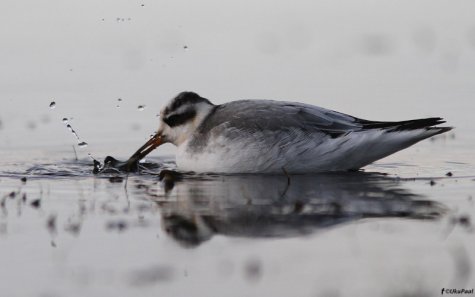Photo: Uku Paal
Translation: Liis
January 1
Where to start a bird watch that will last the whole year? On some earlier occasions the start has been on Saaremaa, at Sõrve säär, because as a rule serious winter has not arrived there yet in the beginning of January and so some late migrants may be found. But the winter this year is late everywhere and more choices are open, everywhere on the coast swans, Branta geese, ducks and other not yet departed migrant birds can be encountered. On the mainland there is no doubt – the start should be in Läänemaa and on the first day of the year the best bird spots around Haapsalu should be checked.
New Year arrived at Saunja bay, at the former centre of the Silma nature protection area and at once after midnight the first species could be noted on the year list. Harassed by the Haapsalu fireworks the
goldeneyes of Sjaunja bay flew nervously around and the bang of the sparkling wine cork made a
mallard in the reeds quack. With the first species noted one could go to sleep peacefully.
The heavy snowfall that started already in the evening had continued in the night and in the morning a snow cover had fallen that reached half-way to the knees. A pretty sight and not only because the unexpectedly wintery morning was beautiful to see but also because birds in such conditions gather in the few snow free places, it is only needed to find the places.
One of the best spots in North Europe for observing migrating arctic waterfowl is the Põõsaspea peninsula, and there we went for a start. On the way we made a couple of stops and a number of common species got on the species list –
fieldfare,
bullfinch,
redpoll,
siskin raven,
crested tit,
willow tit,
great black-backed gull,
herring gull,
waxwing. At Põõsaspea peninsula there were 6 bird observers in the morning and we observed the migration for 1,5 hours. Species for the year list added up nicely, but for an experienced watcher no-one special caught attention. The most exciting noted species were
auk (3 migrating birds), other new species were
long-tailed ducks (1500 migrating),
goosander,
red-breasted merganser,
red-throated loon,
black-throated loon,
cormorant,
velvet scooter,
common scooter,
whooper swan,
mute swan,
mew gull,
little gull,
black-headed gull,
hooded crow,
greenfinch,
white-tailed eagle (2 young birds, headed towards Osmussaare).
On the last day of the year Uku found near Paldiski, at the Laoküla shore, a red phalarope. Since it was a real rarity (only 15 observations in Estonia) that might not at all stray to Estonia the next year, a twitcher trip had to be undertaken. On the road the year species list was increased by a number of common species – goldfinch, magpie, great tit, blue tit, marsh tit, nuthatch, tree sparrow, black woodpecker, greater spotted woodpecker, starling (12 individuals near Padise), domestic pigeon, jackdaw. At Laoküla beach we went, directed by Uku, to the red phalarope location of yesterday and the bird was busy in the same place, in shallow water at the edge of the seaweed bank – to the year species list a real rarity was added already on the first day of the year; for me it is already my 5th observation of this species in Estonia. To the annual species list a great grey shrike and a wren were added. Among the winter rarities in the same place Uku also discovered a common snipe and two reed buntings, but I didn’t notice them.

The first rarity of the year – a red phalarope (Laoküla beach, Harjumaa. 1.01.2012.)
Since the winter day is short we quickly returned to the surroundings of Haapsalu, the destinations were Põgari and Haeska.On the road
sparrowhawk,
rook and
jay were added to the species list. At Põgari the water reached the road, but the shore area was frozen and we did not find the lapwings and golden plovers seen only a few days ago. At sea a rather large number of swans and ducks were swimming, as new species there were
wigeon,
smew and
tufted duck. Because the sun was already setting we hurried to go to the Haeska birdwatching tower. Here too the shore pastures were frozen but on the dunes in front of the tower we found 24
lapwings. Further away on Matsalu bay a dense duck soup was noteable, on nearer examination it turned out that we had to do with 2000
coots, for this species in winter it is a very large number.
In the evening dusk we got to the Haapsalu water treatment plant, where we first noticed two
grey herons and a moment later also a
common moorhen that is a somewhat more serious winter rarity. The bird excursion on the first day of the year finished at the Promenade hotel, where we found a flock of
gadwalls at the shore in the last light.
***
Translator's note:
The regular International mid-winter waterfowl census is coming -
The bird name links in the text lead to short descriptions of the birds on Margus' birder page; in Estonian, but there are also Latin names, to help find the bird in your language.









